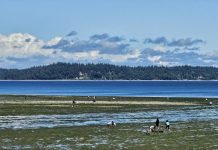Row after row of pools, sitting in the back of a gravel lot, teeming with life. It’s a story that plays out all over the state, where fish are raised for release in various waterways. But within the walls and pathways of the Puyallup Fish Hatchery, an entire ecosystem unfolds, with many communities, organizations, and species playing a role.
The History of the Puyallup Fish Hatchery
In 1949, the original hatchery opened as a way to bolster the local fishing industry, raising trout to stock the nearby lakes. Run by the Washington State Department of Fish and Wildlife, it spent decades as a quiet but active part of the area’s outdoor recreation scene.
A significant shift started in 2012 when some locals set out to create educational opportunities to link the hatchery to the larger community. One of them, Peggy Carter, had initially come to explore the space with a neighbor and felt compelled to help promote and preserve it. Today, she serves as Founding Director of the Puyallup Historical Hatchery Foundation, which was instrumental in getting the facility on the State and National Registry of Historic Places.

While the architecture of the original building has been preserved, the facilities themselves got a major renovation from 2018 to 2020, which improved the shape and condition of several of the ponds to better suit the fish.
Community at the Puyallup Fish Hatchery
The foundation was also responsible for bringing schools to the hatchery, offering a unique chance for students to study ecology firsthand. In 2016, the Puyallup School District launched a STEM program for fourth graders based around outdoor learning and the life cycles of salmon.
As Jason Smith, the Hatchery Operations Manager for the South Puget Sound region of the Washington Department of Fish & Wildlife, explained, “It’s nice to bring children in and let them know what is happening.”

Of course, there’s a broad audience of visitors. Puyallup Fish Hatchery hosts everyone from high school classes and homeschoolers to senior citizens. They even hosted a youth group from Massachusetts, who built the bog garden that still sits outside the Education Center.
Plenty of community partnerships also help keep the operations running, with local Indigenous tribes playing a significant role. The Coho salmon were originally brought in as part of a collaboration with the Puyallup Tribe to increase fish populations, and they still play an active role in the raising and releasing process for the Spring Chinook. Meanwhile, the Muckleshoot Tribe provides the Spring Chinook eggs for each new breeding season. Both tribes also offer larger support to the facility as a whole, such as providing grants for various projects.
The area itself is ideally suited for raising hatchlings. While most similar facilities run up substantial energy bills pumping water from nearby rivers, the Puyallup Hatchery has a perfect resource in the form of Maplewood Springs. Not only is the water plentiful and clean (so clean, in fact, that it is also used by the city of Puyallup), but it flows downhill, forming natural momentum to keep everything running smoothly.

Meet the Fish at the Puyallup Fish Hatchery
This makes the perfect home for the main attraction: fish, and plenty of them. Approximately 300,000 Coho salmon, 600,000 – 800,000 Spring Chinook salmon, and 250,000 rainbow trout call the place home throughout the year. While they are all raised here, their paths differ significantly as they return to some of the most vital environments in Washington.
The Spring Chinook, which are raised from eggs, spend several months in the pools until they are big enough to move to the upper White River Watershed, while the rainbow trout arrive in the fall and are released the following spring into lakes all over the area for anglers to catch.
Then there are the Coho salmon. Near the end of winter, they arrive as fry (the term for young fish) and spend more than a year growing. Each April, they go directly out into nearby Clarks Creek, where they can travel onwards into the Puyallup River. Many of them even make it all the way to the Salish Sea, where they become part of the crucial food chain for orcas. And eventually, later in the year, a few of them will even make their way back.
Walk into the wooded area just behind the main ponds, and you’ll see the picturesque stream wings its way through the woods, filled with gravel perfect for building nests and surrounded by a lovely canopy of trees that provide necessary shade. As Carter explained, “Everything is provided for us to teach here.” It’s all part of the ongoing cycle of seasons, which runs everything from raising fish to the lessons for students.

There are plenty of ways to celebrate the aquatic residents throughout the year. On the first Saturday of each October, the Salmon Homecoming Event celebrates the return journey to Cedar Creek, complete with food, music, arts and crafts, and the chance to see some of the intrepid creatures heading back upstream.
The Puyallup Historic Fish Hatchery is located at 1416 14th Street SW in Puyallup. Group tours can be booked via email at puyalluphatchery@yahoo.com, and individuals are welcome to explore the facility during standard business hours from 8 a.m. – 4 p.m. Be sure to pick up a brochure for a self-guided tour at the Education Center!
For more information, visit the hatchery’s Facebook page.





































